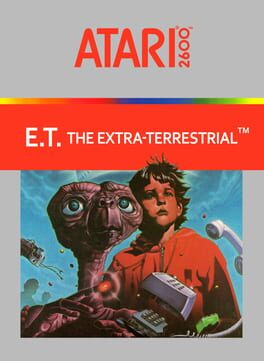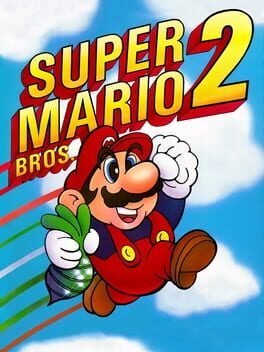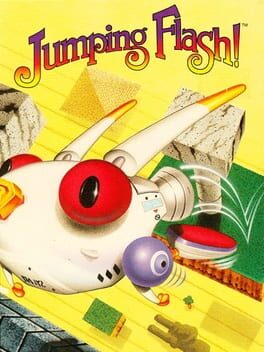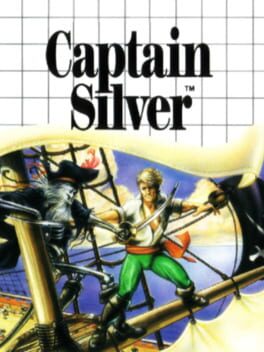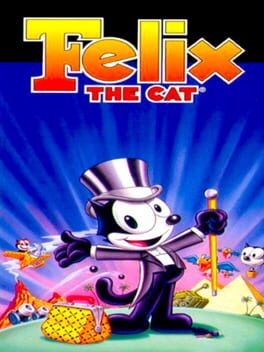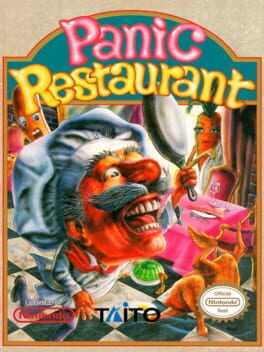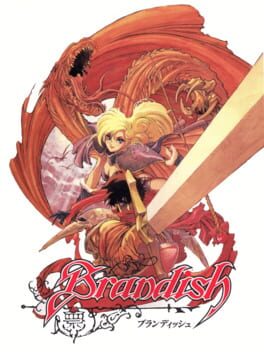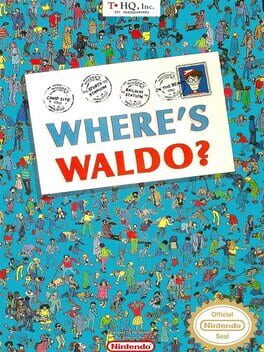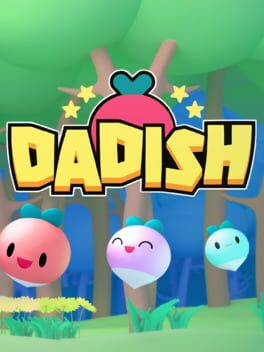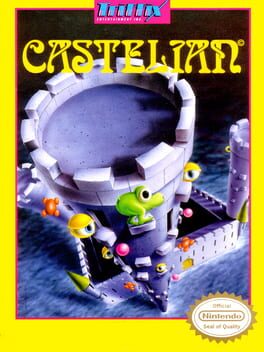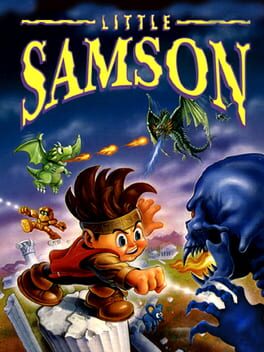OddTurtle
This is a game that has absolutely no right to look, sound, and play as well as it does. It’s a genuine hidden gem on the GBC. The pixel art is impressive, the music is incredible (has a bit of a demo scene vibe, almost), and it plays great too. The only major flaws are some enemies that come out of nowhere and some collectibles that are cryptic to reach. (I swear there’s one in the last stage that you can’t collect at first, then later you get a slightly higher jump for no reason and can come back to get it. Very odd.) There’s also some serious attention to detail here - most enemies can blow themselves up with their own munitions, and it’s funny every time they do. If you like GBC games or Looney Tunes it’s well worth a play.
After fiddling around with this game for less than 2 hours I can confidently say that anyone who thinks this is one of the worst games ever made has either
1. Never played another 2600 game in their life
2. Didn’t read the manual
Seriously y’all need to calm down about this one. Not that it’s perfect, obviously. Getting out of pits is easy with practice but sometimes you fall into one on a screen transition. Or the fact that humans will frequently walk onto the screen while you’re waiting for the timer and ruin your attempt. But it’s pretty ambitious for a 2600 game, and unfortunately it was a bit of a rush job. It didn’t crash the video game industry, Atari did by wasting money producing way more copies of this than anyone could reasonably sell. Give this one a chance (with a manual at your side) and you might actually have a little fun with it! But play Yars’ Revenge first. Or maybe just play that actually
1. Never played another 2600 game in their life
2. Didn’t read the manual
Seriously y’all need to calm down about this one. Not that it’s perfect, obviously. Getting out of pits is easy with practice but sometimes you fall into one on a screen transition. Or the fact that humans will frequently walk onto the screen while you’re waiting for the timer and ruin your attempt. But it’s pretty ambitious for a 2600 game, and unfortunately it was a bit of a rush job. It didn’t crash the video game industry, Atari did by wasting money producing way more copies of this than anyone could reasonably sell. Give this one a chance (with a manual at your side) and you might actually have a little fun with it! But play Yars’ Revenge first. Or maybe just play that actually
There’s a lot to say about this game, and I definitely think it’s worth not only playing but 100%ing, but I just wanna take a moment to appreciate the background art. The locales in Mario Wonder are just exquisite, and the huge, varied, sprawling backgrounds really help sell these places as their own spaces. World 3 with its geometric formations and warm colors was a personal favorite not just in this game but in any Mario game I’ve played.
1988
The Mario game that dared to ask, "What if we had two desert worlds?"
In all honesty though, I really loved this one. First the presentation is excellent, with really clean and expressive spritework. The environments are all very simple, but there are a lot of little odd details that fill it with life. The whales are my new favorite Mario characters. The sound is fine; the music is iconic (I love the character select theme) but the sound effects are a bit grating, especially when climbing. Tying together the look and feel is the near-complete lack of a HUD. I adore games with minimal UI, it really makes the world that much more immersive and in this instance it emphasizes that dreamlike feel.
On the flip side are the mechanics, and I must say that no matter how you personally feel about the plucking mechanics, the game does a beautiful job integrating them into the world. You can pull vegetables out of the ground to use as ammo, and you can also pick up enemies to throw them at each other. Over time, the game will iterate on this in fascinating ways. At first, you'll only be avoiding enemies and tossing vegetable to get them out of the way. The levels will often line enemies up in such a way that you can take out several in one chain shot if you aim precisely. Eventually, however, the game takes advantage of your ability to stand on top of enemies to create tougher platforming. The first boss you face, Birdo, tests your skills by forcing you to jump on top of her own projectiles and chuck them back at her. She appears numerous times throughout, in different variations and arenas. Later, I was jumpscared by her appearance near the beginning of a level, only to realize with a start that I was meant to hitch a ride on one of her eggs to the other side of a large gap. In World 1, you time your jumps to avoid the leaping Trouters. In World 5, you time your jumps to land on top of the leaping Trouters. These moments of discovery and realization were an absolute delight. Almost every challenge is built on the core mechanic, and as such the game creates a cohesive, satisfying world.
Finally, the last element that cemented this as a classic to me were the secrets. There's a lot more to discover than I was expecting, starting with the subworld. You can pluck potions out of the ground which will spawn a door when thrown. Entering leads to a subworld which creates a dark mirror image of the current screen centered on the door. Any pluckable objects in the mirror world become coins that give chances for more lives, and hidden at certain points in the level are mushrooms that give you more HP. The game begins playing with this concept almost immediately, hiding mushrooms in difficult or secret locations forcing you to choose carefully where to place the door. I know there's a mushroom here, but I could get a big patch of coins over there. Do I need to survive now or can I take a chance at more lives? Discovering where the mushrooms were was quite enjoyable, but there's even more to the subworld than meets the eye. The first time I discovered a secret warp, my jaw dropped. Outside of the subworld, there are some levels where a little exploration will allow you to skip ahead, as early as the first level.
Though I did visit every level, I am absolutely certain that there is plenty I didn't see in this world, and I am sure that I will be revisiting it many times.
In all honesty though, I really loved this one. First the presentation is excellent, with really clean and expressive spritework. The environments are all very simple, but there are a lot of little odd details that fill it with life. The whales are my new favorite Mario characters. The sound is fine; the music is iconic (I love the character select theme) but the sound effects are a bit grating, especially when climbing. Tying together the look and feel is the near-complete lack of a HUD. I adore games with minimal UI, it really makes the world that much more immersive and in this instance it emphasizes that dreamlike feel.
On the flip side are the mechanics, and I must say that no matter how you personally feel about the plucking mechanics, the game does a beautiful job integrating them into the world. You can pull vegetables out of the ground to use as ammo, and you can also pick up enemies to throw them at each other. Over time, the game will iterate on this in fascinating ways. At first, you'll only be avoiding enemies and tossing vegetable to get them out of the way. The levels will often line enemies up in such a way that you can take out several in one chain shot if you aim precisely. Eventually, however, the game takes advantage of your ability to stand on top of enemies to create tougher platforming. The first boss you face, Birdo, tests your skills by forcing you to jump on top of her own projectiles and chuck them back at her. She appears numerous times throughout, in different variations and arenas. Later, I was jumpscared by her appearance near the beginning of a level, only to realize with a start that I was meant to hitch a ride on one of her eggs to the other side of a large gap. In World 1, you time your jumps to avoid the leaping Trouters. In World 5, you time your jumps to land on top of the leaping Trouters. These moments of discovery and realization were an absolute delight. Almost every challenge is built on the core mechanic, and as such the game creates a cohesive, satisfying world.
Finally, the last element that cemented this as a classic to me were the secrets. There's a lot more to discover than I was expecting, starting with the subworld. You can pluck potions out of the ground which will spawn a door when thrown. Entering leads to a subworld which creates a dark mirror image of the current screen centered on the door. Any pluckable objects in the mirror world become coins that give chances for more lives, and hidden at certain points in the level are mushrooms that give you more HP. The game begins playing with this concept almost immediately, hiding mushrooms in difficult or secret locations forcing you to choose carefully where to place the door. I know there's a mushroom here, but I could get a big patch of coins over there. Do I need to survive now or can I take a chance at more lives? Discovering where the mushrooms were was quite enjoyable, but there's even more to the subworld than meets the eye. The first time I discovered a secret warp, my jaw dropped. Outside of the subworld, there are some levels where a little exploration will allow you to skip ahead, as early as the first level.
Though I did visit every level, I am absolutely certain that there is plenty I didn't see in this world, and I am sure that I will be revisiting it many times.
1995
1994
101% completed. Didn’t expect to enjoy this as much as I did. I like my platformers precision-based rather than momentum-based, so this was right up my alley. This game really shines in its simple, intuitive level design and it’s obvious that a lot of care went into making sure the striking visuals didn’t interfere with the gameplay. Definitely plan to check out the sequels.
1987
A fun, short-but-sweet action platformer with some incredibly baffling regional differences. I played the Master System version, which has six stages… unless, of course, you play the American version. In the US, they used a smaller cartridge size and consequently had to cut the third and fourth stages. As a result, reading the manual gives some extremely incorrect ideas about what the game will actually contain, listing four whole bosses that simply don’t appear. You can probably guess how baffling the whole experience was.
As for the game itself, it’s honestly pretty good. The combat is quick since enemies generally die in one hit. The controls are pretty smooth and responsive. Where Captain Silver really shines, however, are the visuals. The first stage especially is one of the better visuals I’ve seen on the console. Our hero himself does look kind of odd though, with his head always tilted towards the ground in a forlorn expression.
The final stage (stage 4 in the version I played) does take a turn for the worse, switching from action to pure platforming. There are a ton of moving cloud platforms and they always turn right before you expect them to, leading to many untimely deaths. What’s worse is that when you make it to the second screen, if you fall down to the first and die, your checkpoint gets reset to the start of the stage instead of the second screen. Frustrating.
Overall, I enjoyed my (incredibly short) time with Captain Silver. At some point I’ll probably return to play the “full” version. In the meantime, this is the first review for the game on here! If this kind of game is your style, definitely play the European/Japanese version for the true experience.
As for the game itself, it’s honestly pretty good. The combat is quick since enemies generally die in one hit. The controls are pretty smooth and responsive. Where Captain Silver really shines, however, are the visuals. The first stage especially is one of the better visuals I’ve seen on the console. Our hero himself does look kind of odd though, with his head always tilted towards the ground in a forlorn expression.
The final stage (stage 4 in the version I played) does take a turn for the worse, switching from action to pure platforming. There are a ton of moving cloud platforms and they always turn right before you expect them to, leading to many untimely deaths. What’s worse is that when you make it to the second screen, if you fall down to the first and die, your checkpoint gets reset to the start of the stage instead of the second screen. Frustrating.
Overall, I enjoyed my (incredibly short) time with Captain Silver. At some point I’ll probably return to play the “full” version. In the meantime, this is the first review for the game on here! If this kind of game is your style, definitely play the European/Japanese version for the true experience.
1992
A nice, simple breezy game that I finished in a few hours. The only truly challenging parts are the final boss and the levels where you’re on the surface of the water. I appreciated that every type of level had different stages of powerups, though it was a little odd that not every type had the same number. The normal platforming stages have four, but the flying levels only have three, and the space level just has one. The controls were a tad slippery but overall fun. The art was a bit janky in some places (like the space levels) but great in others (like the beach, had a great Wonder Boy vibe). Not a fan of the music.
1992
A fine enough little NES action platformer, but there are a few hitches holding it back. The biggest one is that some of the enemy placements are just plain cheap. The kebabs in the fourth stage move so fast that you absolutely have to memorize where they are. I still haven’t figured out how to beat the wok boss without getting hit. The leaping fish in the last stage move way too fast to dodge as well. Your plucky little chef moves very slowly, which I’m fine with, but the enemies sometimes feel like they were built for a different character.
The extra weapons you can pick up make for a mixed bag. The spoon, which extends your reach a bit, is fine but you never feel relieved to see it. The ranged attack, the dishes, are excellent in the third stage to get rid of the toaster enemies, but otherwise their arc makes them unwieldy. The fork, which operates like a pogo stick, is genuinely useless. No clue what it’s here for. In truth, your base frying pan feels perfectly adequate for most of the game, with the extra weapons not providing much for dynamic play.
Finally, the bonus games you can enter are functionally worthless. They only give you points, and while points can get you more lives, the number you get from these games is paltry. The most I ever got was 1800, and I’m pretty sure you need 50,000 for another life. The one in stage 5 does seem to skip you ahead a few rooms, though, so it’s always worth it.
There is plenty of detail in the stages, each of which presents unique enemies and obstacles. The music and sound were pleasant as well.
All in all, Panic Restaurant just lacks a bit of polish. It’s fun if you’re into retro action platformers, but it isn’t a great way to get into them, and it certainly isn’t worth the price an authentic cartridge will run you nowadays.
The extra weapons you can pick up make for a mixed bag. The spoon, which extends your reach a bit, is fine but you never feel relieved to see it. The ranged attack, the dishes, are excellent in the third stage to get rid of the toaster enemies, but otherwise their arc makes them unwieldy. The fork, which operates like a pogo stick, is genuinely useless. No clue what it’s here for. In truth, your base frying pan feels perfectly adequate for most of the game, with the extra weapons not providing much for dynamic play.
Finally, the bonus games you can enter are functionally worthless. They only give you points, and while points can get you more lives, the number you get from these games is paltry. The most I ever got was 1800, and I’m pretty sure you need 50,000 for another life. The one in stage 5 does seem to skip you ahead a few rooms, though, so it’s always worth it.
There is plenty of detail in the stages, each of which presents unique enemies and obstacles. The music and sound were pleasant as well.
All in all, Panic Restaurant just lacks a bit of polish. It’s fun if you’re into retro action platformers, but it isn’t a great way to get into them, and it certainly isn’t worth the price an authentic cartridge will run you nowadays.
1991
Brandish is not what it seems. Judging by appearances, one might initially assume that it's a top-down action RPG, akin to A Link to the Past and other such games. In truth, though, Brandish is a pure-blooded first-person dungeon crawler that just happens to not be first-person. The camera is the most obvious example of this, and it is what turns most players off. Unlike a standard action RPG, moving left and right will not move the player across the screen, but will instead reorient you to face the direction you pressed. Basically, Brandish has tank controls, including the ability to strafe with the shoulder buttons. If this bothers you, there is an option to switch the turn and strafe buttons, so you move like an action RPG and hold the shoulder buttons to rotate. However, I highly recommend playing with the standard controls, as the way the dungeons are set up strongly emphasizes constant rotation to orient yourself. If you can get into a first-person dungeon crawler, you'll have no problem with this.
If you can get past the initial impressions of the controls, Brandish has a lot to offer. The real-time combat is interesting and varied. Enemies wander the halls, and they have a wide variety of attack patterns and behaviors. The top-down view opens the way both for methodical battles based on positioning and orientation as well as frantic, tense scrambles where an enemy unexpectedly approaches from a bad angle. You gain a few spells as you go that each have different patterns, and I found that each and every one had different uses for different foes.
Brandish also had some very nice QOL features that I was not expecting from a 1991 release. First, the game also features auto-saving every time you change floors, which saved me many times throughout my playthrough. It also has a detailed auto-map that I referenced constantly as I went. The fact that illusory walls display on the map was the cherry on top that made exploration a dream.
The game is mechanically sound, but what made my journey a worthwhile one was the atmosphere. The story follows Varik (at least in the English SNES version, what I played), an outlaw being chased by a sorceress named Alexis. During a confrontation, you both slip into a deep pit, and end up in a cursed underground kindgom, which has been transformed into a monster-filled labyrinth. Your goal is simply to find a way out (while avoiding Alexis). The game begins by simply dropping you into the ruins to fend for yourself, entirely alone. In fact, you spend nearly the entire game isolated, with only the occasional run-in with shops or the aforementioned Alexis. The atmosphere is mysterious and foreboding, and the first several shopkeepers you speak with give off an intense sense of hopelessness and melancholy. You find treasure chests, but you also find dropped items from previous adventurers. As you progress past the initial ruins and enter the tower, the mystery gives way to a grim, determined march. The shopkeepers get less hopeless and more jaded. The last true shopkeepers you meet lament that they could not go further after making it so far. By the end, you truly feel like a hardened warrior.
I would be remiss if I did not talk about the score, which was easily the best part of the entire experience. Every single song is a new banger, which is great when you'll be hearing the same track for 10 floors in a row. The standouts were the file select theme and the two shop themes especially. The first shop theme is a slow, somber waltz, used heavily at the beginning of the game to complement the gloomy tone. As you go, though a more punchy, upbeat theme is used more and more, uplifting you and complimenting each break from the action. I'm going to have most of the soundtrack randomly pop in my head for years to come.
The graphics are nice as well, mainly in the still screens which are very well done. The spritework is mostly rather good, though the insectoid enemies look kind of plasticky, with strange, bright colors (the scorpions and lobsters come to mind).
I could say a lot more about Brandish, such as the puzzles, but honestly if any of this interested you, I would highly recommend trying it. The SNES version is very accessible, though I have heard that other versions are more complete and polished. It isn't too long, though make sure to set your game speed to high, only turning down when the action gets to fast to parse.
I will absolutely be playing the sequel.
If you can get past the initial impressions of the controls, Brandish has a lot to offer. The real-time combat is interesting and varied. Enemies wander the halls, and they have a wide variety of attack patterns and behaviors. The top-down view opens the way both for methodical battles based on positioning and orientation as well as frantic, tense scrambles where an enemy unexpectedly approaches from a bad angle. You gain a few spells as you go that each have different patterns, and I found that each and every one had different uses for different foes.
Brandish also had some very nice QOL features that I was not expecting from a 1991 release. First, the game also features auto-saving every time you change floors, which saved me many times throughout my playthrough. It also has a detailed auto-map that I referenced constantly as I went. The fact that illusory walls display on the map was the cherry on top that made exploration a dream.
The game is mechanically sound, but what made my journey a worthwhile one was the atmosphere. The story follows Varik (at least in the English SNES version, what I played), an outlaw being chased by a sorceress named Alexis. During a confrontation, you both slip into a deep pit, and end up in a cursed underground kindgom, which has been transformed into a monster-filled labyrinth. Your goal is simply to find a way out (while avoiding Alexis). The game begins by simply dropping you into the ruins to fend for yourself, entirely alone. In fact, you spend nearly the entire game isolated, with only the occasional run-in with shops or the aforementioned Alexis. The atmosphere is mysterious and foreboding, and the first several shopkeepers you speak with give off an intense sense of hopelessness and melancholy. You find treasure chests, but you also find dropped items from previous adventurers. As you progress past the initial ruins and enter the tower, the mystery gives way to a grim, determined march. The shopkeepers get less hopeless and more jaded. The last true shopkeepers you meet lament that they could not go further after making it so far. By the end, you truly feel like a hardened warrior.
I would be remiss if I did not talk about the score, which was easily the best part of the entire experience. Every single song is a new banger, which is great when you'll be hearing the same track for 10 floors in a row. The standouts were the file select theme and the two shop themes especially. The first shop theme is a slow, somber waltz, used heavily at the beginning of the game to complement the gloomy tone. As you go, though a more punchy, upbeat theme is used more and more, uplifting you and complimenting each break from the action. I'm going to have most of the soundtrack randomly pop in my head for years to come.
The graphics are nice as well, mainly in the still screens which are very well done. The spritework is mostly rather good, though the insectoid enemies look kind of plasticky, with strange, bright colors (the scorpions and lobsters come to mind).
I could say a lot more about Brandish, such as the puzzles, but honestly if any of this interested you, I would highly recommend trying it. The SNES version is very accessible, though I have heard that other versions are more complete and polished. It isn't too long, though make sure to set your game speed to high, only turning down when the action gets to fast to parse.
I will absolutely be playing the sequel.
1991
My lord, this was terrible. If it were just the Waldo levels it would just be bad, since the actual figure of Waldo is just barely legible given the low resolution of the NES. They do get rearranged each time you play, so theoretically I can see a kid actually having fun with them. What elevates this game to “terrible” are the other levels. The cave level takes about 5 seconds of fumbling to win, the subway level is pure agony with a randomly teleporting wizard guy that rapidly drains your time, and I cannot believe you have to successfully match a slot machine to finish the game. I don’t want to sound like a particular brand of upset internet reviewer, but I really am curious as to what they were thinking. If they had just thrown together a few more normal Waldo levels instead I don’t think I would have had a very bad time with this.
2020
A fun little platformer I got at a heavy discount. The controls are nice and meaty, and the stars were mostly all fun to collect. I can't say I enjoyed the mushroom levels too much, the bounces felt a bit too unpredictable for my taste.
One thing that particularly amused me about this game was how much the creator blantantly, yet lovingly, incorporated from other games. Yes, I noticed the Kirby's Adventure clouds in the background, and the Mario sound effects, and what I'm sure were instruments from the DKC games in the background of the mountain levels. Overall it creates a charming little package, though it isn't one I think is worth the full $10 asking price on the Switch. Get it on sale and it makes a fine way to whittle away an afternoon.
One thing that particularly amused me about this game was how much the creator blantantly, yet lovingly, incorporated from other games. Yes, I noticed the Kirby's Adventure clouds in the background, and the Mario sound effects, and what I'm sure were instruments from the DKC games in the background of the mountain levels. Overall it creates a charming little package, though it isn't one I think is worth the full $10 asking price on the Switch. Get it on sale and it makes a fine way to whittle away an afternoon.
1991
Castelian apparently began life as a computer game under a different name, which is incredibly self-evident from the game itself. The entire game oozes this eerie, uncanny charm, from the complete lack of music in the main stages to the alien physics to the bizarre stage names which range from “The Tower of Eyes” to “Swimmers Delight” (couldn’t figure out what that latter one meant). Another baffling feature that adds to the strangeness is your character’s idle animation - the little guy goes to sleep, which is relatively normal. What isn’t is that you can’t start moving again until he finishes a waking up animation. This got me killed on more than one occasion.
Castelian’s visuals are its standout feature, with the central towers rotating uncannily smoothly akin to that one section in Kirby’s Adventure, and our pudgy little protagonist animating very nicely, albeit at a detriment to the controls.
Overall I had a good time with the game, as it’s just short enough that the ending always feels within reach no matter how many times you die.
Castelian’s visuals are its standout feature, with the central towers rotating uncannily smoothly akin to that one section in Kirby’s Adventure, and our pudgy little protagonist animating very nicely, albeit at a detriment to the controls.
Overall I had a good time with the game, as it’s just short enough that the ending always feels within reach no matter how many times you die.
1992
This one just really didn’t click with me. I really thought I’d enjoy it more, what with it being a late-era NES platformer, but by the time I was around 2/3 of the way in, I just couldn’t take it anymore and started using save states. I think what took this game from challenging to frustrating can be boiled down to a single design decision: if you die as any character but the lead, that character is permanently gone until you game over or finish the stage. Now, this is a game that clearly wants you to constantly swap between its four protagonists to solve problems as they appear. You can choose to tackle each problem with any character. However, it definitely feels like some characters are much more optimal than others in each situation, especially for the bosses. If I’m trying to beat a boss with the dragon, and upon dying, I can no longer play as the dragon, it just makes me want to stop playing. No other character can deal with this situation the way the dragon can and repeatedly dying to game over and get her back sounds like a waste of my time. I think this system is trying to incentivize me to try more characters, but personally I’d prefer to have the choice to bang my head against a problem as many times as I’d like before deciding to switch. It’s incredible how a single factor can really ruin the experience.
As for what I liked, there was quite a bit. The music is memorable, and the graphics are gorgeous (though they get kind of messy in some places). Where this game really excels is control. All four characters feel smooth and responsive to play, and over time you really get a strong sense of when to swap to use their unique strengths.
If I were to suggest a change, it would be to revive all characters when you die. This would make things much less frustrating and would also free up the lead character to have an ability other than climbing, since that’s the mouse’s power. Personally I’d give him a spread shot or something since none of the characters are great at dealing with threats that come in diagonally.
Maybe I’ll warm up to this over time. Like many NES games, it probably gets better on repeat playthroughs as you learn the mechanics.
As for what I liked, there was quite a bit. The music is memorable, and the graphics are gorgeous (though they get kind of messy in some places). Where this game really excels is control. All four characters feel smooth and responsive to play, and over time you really get a strong sense of when to swap to use their unique strengths.
If I were to suggest a change, it would be to revive all characters when you die. This would make things much less frustrating and would also free up the lead character to have an ability other than climbing, since that’s the mouse’s power. Personally I’d give him a spread shot or something since none of the characters are great at dealing with threats that come in diagonally.
Maybe I’ll warm up to this over time. Like many NES games, it probably gets better on repeat playthroughs as you learn the mechanics.

